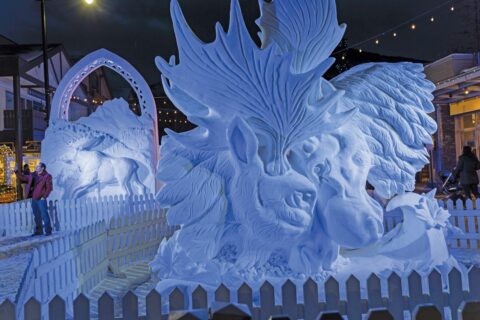March 15, 2021 • Mountain Living
WildSmart in the Mountains
By Kate Barker with Nick de Ruyter, WildSmart Program Director
Living outside and loving the wilderness puts people in the path of the Bow Valley’s long-term residents: local wildlife. In order to strive for coexistance, or the ability for humans and wildlife to live peacefully alongside one another, people must be responsible in the ways they interact with the natural world. But how do you know what the best practices are for recreating in the mountains? We spoke with Nick de Ruyter, WildSmart Program Director to find out.
Q. What does WildSmart do for the Bow Valley community?
A. The WildSmart Program encourages efforts by the Bow Valley community to reduce negative human-wildlife interactions. In the Bow Valley, people and wildlife are close neighbours and education, public awareness, and community support for wildlife conservation are essential to our long-term coexistence. Having a well-informed WildSmart community helps lead to sustainable wildlife populations and a reduction in human-wildlife conflicts.
WildSmart uses diverse educational tools to build a culture of safe and responsible behaviour, including classroom presentations, wildlife awareness/safety workshops, bear spray training, and in-depth collaborations with volunteers who educate their fellow citizens. We conduct targeted research to understand interconnected social and ecological questions, such as how to balance human activity and wildlife conservation, and we engage citizens in tangible, community-led projects. Our programs aim to incorporate best practices and promote innovative approaches to wildlife conservation in the Bow Valley.
Q. Can you tell me about your Education and Outreach programs?
A. Our Education and Outreach programs teach youth, residents, local businesses and visitors how to coexist with grizzly bears, cougars, wolves, elk, coyotes and other wildlife, promoting a culture of safety and respect for our wild neighbours. In 2019, in-person programs were delivered to over 20,000 residents and visitors to the region about topics such as wildlife ecology, how to safely coexist with wildlife, how to avoid and manage encounters with wildlife, responsible trail use, how to use bear spray, and attractant management. In-person programs also include delivering training to staff at local businesses and hotels, as well as staff at larger Outdoor Stores in Calgary such as MEC and Campers Village. Even though some of the education and outreach programs focus on different topics, the underlying theme of all our education is keeping people and wildlife safe, as well as learning how to be a responsible trail user and environmental steward.
In addition, we manage a group of 25 dedicated volunteers from the community known as the Wildlife Ambassadors and they have conversations with residents and visitors in the Bow Valley and Kananaskis Country about wildlife ecology and safety information, as well as best practices for responsible recreation. They help out at Community events and also head out to various trailheads, day-use areas and campgrounds throughout the Bow Valley and Kananaskis Country.
Other education and outreach includes Social media (Facebook and Instagram) which is often used to help educate a large audience to whom we are not able to deliver programs to in-person, developing brochures, stickers and takeaway materials, and digital content such as our Weekly Bear Report.
A big part of my job is public and media relations, involving stakeholder engagement and regular interactions with the local and Calgary based media (Newspapers and Radio). We have excellent relationships with all the major networks with frequent appearances on Global, CBC and CTV TV, as well as CBC radio.
In light of the COVID-19 pandemic, we are offering online-based program delivery of our grades K-12 Climate Change and Wildlife programs to schools in the Bow Valley, as well as for our wildlife awareness/safety workshops which are being delivered online to youth groups and foreign born residents who have recently moved to the Bow Valley, just to name a few.
All of our Wildlife and Climate Change Lesson Plans, along with supplementary materials and video interviews with subject matter experts, can be found on our website.
Unfortunately, our usual community events and bear spray training have all been cancelled due to the pandemic but we have been able to create videos available online about topics such as:
- How to Avoid and Handle Encounters with Wildlife: (https://youtu.be/nUCuhwxB7s0)
- How to Properly Use Bear Spray: (https://www.biosphereinstitute.org/bearspray) which we are able to offer with subtitles in 10 languages in hopes of increasing our reach to new audiences, and creating additional inclusive leisure and recreation opportunities for non-English speaking residents and visitors.
- Staying Safe in Bear Country, a video we made this summer with CBC: (https://www.facebook.com/cbccalgary/videos/1179129472452801/?d=n)
During this pandemic, WildSmart has continued to publish Weekly Bear Reports and provide wildlife safety communications through media and social media outlets. We also created a new Instagram account (@bvwildsmart) together with the Volunteer Wildlife Ambassadors in order to be able to spread important coexistence messaging with residents and visitors during COVID-19 and going forward.
Q. Can you touch on attractant management and how the community can come together to keep wildlife in the wild?
A. In order to keep wildlife outside of developed areas, we as a community need to be proactive and do our part to manage all of our attractants and help keep wildlife such as bears out of trouble. Because of where we live, it is inevitable that bears and other wildlife may pass through residential areas and backyards, but it is up to us to ensure we do not carelessly leave out attractants that may draw them into town or give them a reason to linger in our yards. Bears that gain access to attractants such as garbage, pet food, birdseed, greasy bbq’s, fruit trees and berry bushes can lose their natural fear of people, which increases the possibility of human-wildlife conflict. These bears can cause injury to people and pets and destroy property, often resulting in bears being relocated or destroyed. If people are set on keeping their fruit trees than they need to take responsibility and ensure that all the fruit is removed from the tree and off the ground BEFORE wildlife gains access to it. In order to avoid drawing wildlife into town, we all need to do a better job of managing our attractants.
Can you touch on recreation in the community, and how to move about in coexistence with wildlife?
Recreation is very popular in the Bow Valley year-round and there seems to be an increase in participation in activities such as mountain biking, trail running, hiking, rock climbing, cross-country skiing and snowshoeing. In addition, more people are accessing the backcountry (i.e. bike packing, ultra-marathon runners) so areas that were undisturbed in the past, now see many visitors per year.
We live in a narrow valley with two major roads, a river, a railroad and lots of development, so it is difficult for wildlife to navigate through and live in this area. We are seeing more people out on the trails year round now with activities such as fat biking, cross country skiing and snowshoeing becoming more popular in the winter. In addition, people have started recreating in the early morning and at night, which are the times when wildlife are most active because they have become accustomed to that that being the only time of day when they can avoid people. However, now that people are also using the trails at night, it makes it very difficult for wildlife to “live” undisturbed. The presence of people can affect their sleeping patterns, feeding patterns, mating patterns, parenting patterns etc.
We are at the point where people who like to recreate in the Bow Valley may need to make some sacrifices and change their behaviour in order for wildlife to thrive and survive here.
Some simple things that recreationists can do to give wildlife space and better coexist are:
Avoiding important habitat during certain times of year, e.g., during elk calving season, berry season, etc.
Complying with trail closures
Using designated trails only
Recreating between dawn and dusk only
Keeping pets on a leash
Q. How does learning to live without conflict alongside wildlife build a stronger sense of community?
A. Many people who choose to live in the Bow Valley do so because they love the awe and beauty of the surrounding landscape and wildlife we have here, as well the recreation opportunities available to them. Some people have certainly learned to live without conflict alongside wildlife but there are still many people in our community who feel their actions do not have any consequences and that they do not need to follow the rules. This includes things like walking their pets off-leash, leaving birdseed out year round, not properly storing garbage and attractants, entering closed areas and not staying on designated trails in the wildlife corridors.
Education is important to sustaining health wildlife populations, and the more educated our community is about the issues and solutions the better chance we can have to safely and effectively coexist with wildlife in this valley. That being said, many of our residents have been very well educated on the issues but still choose to disregard the rules and what is best for the wildlife they say they care so much about. We need to figure out how we can get these people to buy-in and change their behaviour to better coexist with wildlife and build a stronger sense of community. Our community needs to be leading by example, otherwise how can we expect visitors to follow the rules!
How can people get more information?
- Website: https://www.biosphereinstitute.org/wildsmart
- Facebook: Bow Valley WildSmart (@wildsmart)
- Instagram: @bvwildsmart
- Weekly Bear Report that gets posted to our website, Facebook, and sent to our mailing list during bear season from early April to late November (https://www.biosphereinstitute.org/bear-report)
- Nature for Newcomers on our website provides wildlife avoidance and safety information in different languages to help reduce language barriers (https://www.biosphereinstitute.org/newcomers)
- We offer a How to Properly Use Bear Spray Video on our website with subtitles in 10 languages (https://www.biosphereinstitute.org/bearspray)



